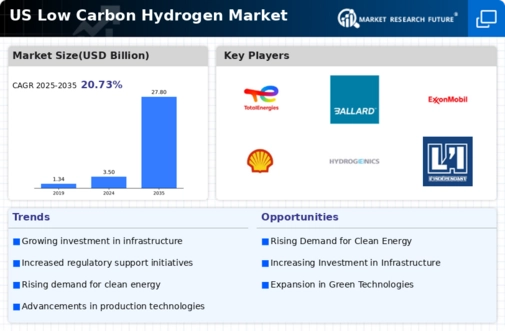The US Low Carbon Hydrogen Market is emerging as a vital element in the transition to sustainable energy, driven by a growing focus on decarbonization and reducing greenhouse gas emissions. This market encompasses various production methods, including electrolysis, biomass gasification, and steam methane reforming, with an increasing emphasis on technologies that minimize carbon output. As the country shifts toward greener energy solutions, stakeholders across the supply chain, including fuel producers, industrial consumers, and technology developers, are positioning themselves to capitalize on this emerging opportunity.
The competitive landscape is characterized by a mix of established energy firms, innovative technology companies, and start-ups, all striving to create a foothold in this dynamic and evolving sector.
Strategic partnerships and investments in infrastructure are crucial as companies seek to enhance their capabilities and meet the rising demand for low carbon hydrogen solutions across various industries.TotalEnergies is making significant strides in the US Low Carbon Hydrogen Market, capitalizing on its strong background in energy production and sustainability initiatives. The company's commitment to diversifying its energy portfolio positions it advantageously in the low carbon hydrogen arena. With a focus on integrating renewable sources with traditional energy production, TotalEnergies is enhancing its competitive edge by investing in innovative technologies aimed at hydrogen production.
This strategy bolsters its market presence, allowing TotalEnergies to leverage its extensive supply chain, established infrastructure, and deep industry expertise. The capacity to adapt to evolving regulatory frameworks and consumer demands further strengthens its position in the low carbon hydrogen landscape, signaling a proactive approach to embracing sustainable energy solutions.Ballard Power Systems is another key player in the US Low Carbon Hydrogen Market, renowned for its contributions to fuel cell technology and hydrogen solutions.
This company specializes in the development and commercialization of proton exchange membrane fuel cell products, which are crucial for various applications, including transportation and stationary power generation. Ballard Power Systems is well-established in the North American market, leveraging its innovative technologies to create efficient energy solutions that align with the country’s push for low carbon alternatives.
The company's strengths lie in its cutting-edge research and development initiatives, ensuring a steady flow of advancements in fuel cell technology. Key partnerships and collaborations with automotive companies bolster its market presence, enabling the integration of hydrogen fuel cells into new vehicle designs. Recent mergers and acquisitions have further enhanced Ballard Power Systems' capabilities, allowing it to expand its manufacturing footprint and increase production efficiencies, thereby solidifying its role in the low carbon hydrogen sector within the United States.























Leave a Comment